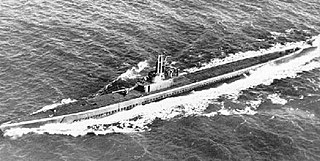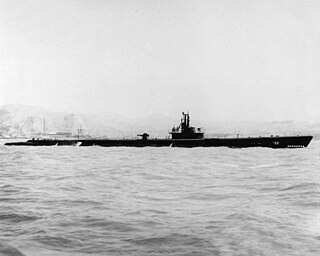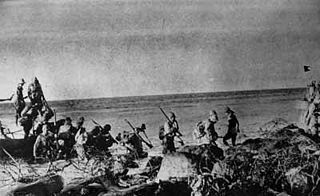
USS Seawolf (SS-197), a Sargo-class submarine, was the second submarine of the United States Navy named for the seawolf.

USS Wahoo (SS-238) was a Gato-class submarine, the first United States Navy ship to be named for the wahoo. Construction started before the U.S. entered World War II, and she was commissioned after entry. Wahoo was assigned to the Pacific theatre. She gained fame as an aggressive and highly successful submarine after Lieutenant Commander Dudley Walker "Mush" Morton became her skipper. She was sunk by Japanese aircraft in October 1943 while returning home from a patrol in the Sea of Japan.

USS Bonefish (SS-223) was a Gato-class submarine, the first United States Navy ship to be named for the bonefish.

USS Halibut (SS-232), a Gato-class submarine, was the first ship of the United States Navy to be named for the halibut, a large species of flatfish.

USS Seadragon (SS-194), a Sargo-class submarine, was the first ship of the United States Navy to be named for the leafy seadragon.

USS Sailfish (SS-192), was a US Sargo-class submarine, originally named Squalus. As Squalus, the submarine sank off the coast of New Hampshire during test dives on 23 May 1939. The sinking drowned 26 crew members, but an ensuing rescue operation, using the McCann Rescue Chamber for the first time, saved the lives of the remaining 33 aboard. Squalus was salvaged in late 1939 and recommissioned as Sailfish in May 1940.

USS Trigger (SS-237) was a Gato-class submarine, the first ship of the United States Navy to be named for the triggerfish.

USS Snook (SS-279), a Gato-class submarine, was the first ship of the United States Navy to be named for the common snook, an Atlantic marine fish that is bluish-gray above and silvery below a black lateral line.

USS Grayback (SS-208), a Tambor-class submarine, was the first ship of the United States Navy to be named for the lake herring, Coregonus artedi. She ranked 20th among all U.S. submarines in total tonnage sunk during World War II, with 63,835 tons, and 24th in number of ships sunk, with 14. She was sunk near Okinawa on 27 February 1944. Her wreck was discovered in June 2019.

USS Drum (SS-228) is a Gato-class submarine of the United States Navy, the first Navy ship named after the drum, a type of fish. Drum is a museum ship in Mobile, Alabama, at Battleship Memorial Park.

USS Flying Fish (SS/AGSS-229), a Gato-class submarine, was the first submarine and second ship of the United States Navy to be named for the flying fish. Flying Fish is credited with having sunk a total of 58,306 tons of Japanese shipping and received 12 battle stars for World War II service.

USS Flasher (SS-249) was a Gato-class submarine which served in the Pacific during World War II. She received the Presidential Unit Citation and six battle stars, and sank 21 ships for a total of 100,231 tons of Japanese shipping, making her one of the most successful American submarines of the War. She was the first ship of the United States Navy to be named for the flasher.

USS Puffer (SS-268), a Gato-class submarine, was the first ship of the United States Navy to be named for the puffer.

The first USS Trepang (SS/AGSS-412) was a Balao-class submarine in the United States Navy. She was named after the trepang, an Indonesian name for a marine animal called a "sea slug" or a "sea cucumber," having a long, tough, muscular body and found in the coral reefs of the East Indies.

USS Seahorse (SS-304), a Balao-class submarine, was the first submarine and second ship of the United States Navy to be named for the seahorse, a small fish whose head and the fore part of its body suggest the head and neck of a horse.
The SS China Maru was a 5,870-gross register ton cargo ship built by Kawasaki Dockyard Company, Kobe, for Kawasaki Kisen KK in 1920.
CH-17 was a No.13-class submarine chaser of the Imperial Japanese Navy during World War II.

Kaimei Maru was a Japanese troop transport ship operated by the Imperial Japanese Army during World War II which was sunk off Honshu on 4 September 1942 by the American submarine USS Guardfish. The ship was a British WWI Type B military cargo ship built by the Hong Kong and Whampoa Dock Company.
Hokkai Maru was a Kinai Maru-class auxiliary transport of the Imperial Japanese Navy during World War II. She participated in the Japanese occupation of British Borneo and was part of ill-fated convoy HI-71.
CH-7 or No. 7 was a No.4-class submarine chaser of the Imperial Japanese Navy during World War II.
















